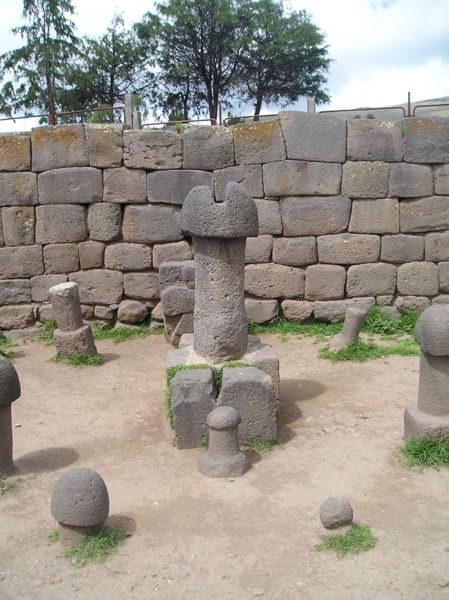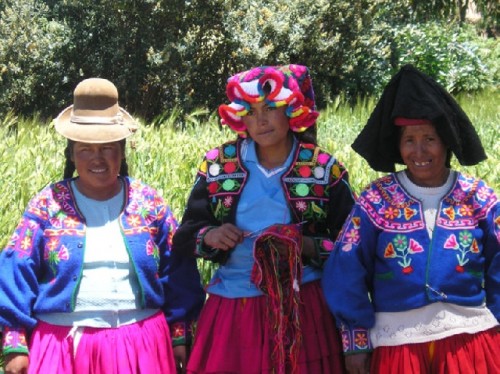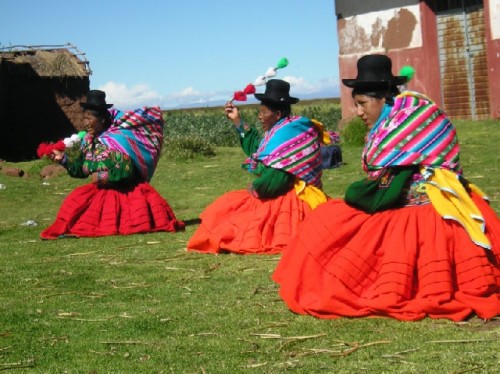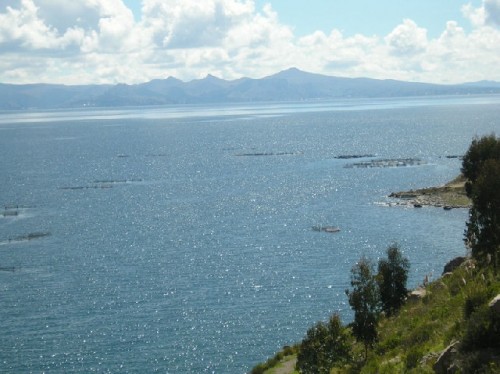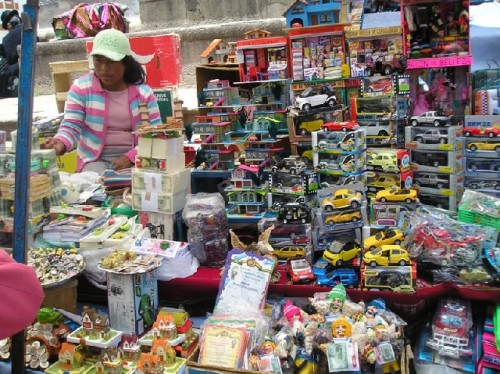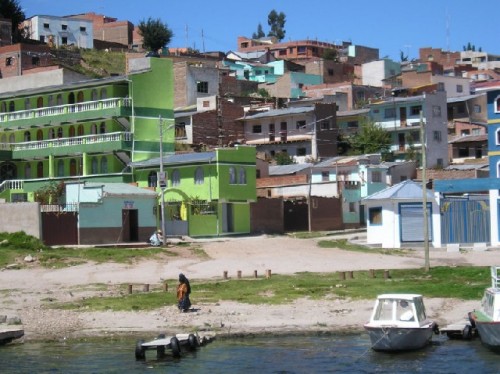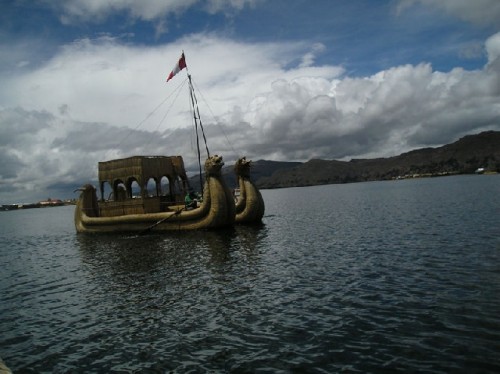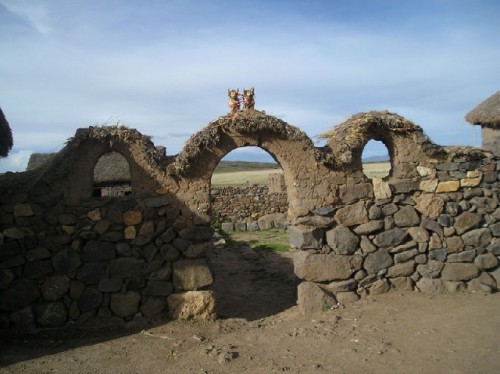Peru: Part Four
Lake Titicaca, Puno and Copamaya, Bolivia
By: Zeren Earls - Sep 15, 2007
Lake Titicaca
Lake Titicaca appeared before we reached Puno, our final destination. Considered the world's highest navigable lake at 12,725 feet, it stretched out to Bolivia at a distance with its turquoise waters. Eager to settle in after a long day, we drove straight to our hotel in Chucioto, 18 km outside of Puno on the lake. The décor of the Taypikala Hotel reflected the richness of the region's folk art. Beautifully framed hand-loomed textiles and knitted hats adorned the walls; table-size replicas of totora reed boats fueled my anticipation of what was yet to come. I settled near the fireplace to enjoy my coca tea, our welcome drink. Following a dinner of kingfish from the lake and quinoa flan I called it a day.
In the morning our local guide taught us a few words in Aymara: "kamisaraki" (how are you), "valiki" (well, thank you), and "yuspara" (thank you). We used these words, accompanied by a handshake, consistently in greeting and thanking villagers during our visits. The day's excursion began at our home base in Chucioto with its notable Incan fertility temple - an enclosure of giant stone phalluses, some broken, some intact. Peruvians practice a composite religion that combines elements of Catholicism with ones of pre-Columbian pagan rites. The nearby Catholic Church has on its roof two phalluses, one of which has been knocked down by lightning.
Lake Titicaca, meaning "wild cat" in Inca, derives its name from its puma or mountain lion shape. For the Inca the puma represented this world, the condor the heavens and the snake the underworld, with the three together creating harmony. According to legend, a pair of gods rose from the waters of Lake Titicaca to found the Incan empire. The lake is 103 miles long, 37 miles wide and 900 feet deep. During the rainy season the water rises 7-8 feet. Surrounded by the Andes, it never freezes, and its temperature varies between 45 and 50 degrees F. Twenty-five freshwater rivers, seven of which are quite big, pour into the lake. Puno, a city of 170,000 people, serves as its harbor, with fishing as the main industry. There are many trout farms on the lake, some of which are owned by Chileans.
The visit to Copamaya, where we had lunch, gave us an insight into rural customs. In this village all women knit and weave. Children and young girls wear knitted caps, and upon marriage become eligible to wear bowler hats. Single women wear their hair in two long braids down their back; married women connect the braids at the ends to indicate their attachment. They buy ornamental hair for a fluffy look at the ends of their braids or to split them further into multiple thin ones.
For lunch we cooked potatoes by burying them in a mound of hot field rocks over burning dung. Retrieving them twenty minutes later, we peeled and ate them with our choice of clay or chili sauce. From a spread of small earthenware pots we helped ourselves to fava beans, with or without shells, fried cheese and quinoa rings made from batter. Our hosts sat separately, women and children squatting or sitting on the ground, men on low benches against a wall, as is the custom throughout the Andes. After lunch our hosts dressed the four women in our group in knitted hats, embroidered jackets and layered skirts. In our rural identity, we paired up with the locals, joining hands and dancing to the rhythms of village tunes. A good time was had by all.
On the way back, hearing the insistent and infectious rhythms of a band, we made an impromptu stop. In a roped-off area by the town hall, dance groups were rehearsing for a competition about to begin. Except on the side reserved for the jurors, crowds lined the perimeters of the performance area. Spotting us in the throng, the mayor came over to welcome us. We declined his kind invitation to join him in the VIP section and preferred to watch standing. We watched one group of 300 dancers, the minimum number required for the competition. The jury, all male with one exception, included the mayor; the prize was two big drums and a six-pack of large bottles of soft drink. I took a photo of the mayor with his secretary - him in Western garb and her in native dress.
For people in the Andes dancing is a part of everyday life; people seem to live to dance. During the carnival dancing even stops traffic. On our way back to Puno, dancers on the street stopped us; we had no choice but to join the spectators lining the street, while musicians on the slopes kept the rhythms going for the foot-stomping couples. Finally impatient truck drivers, loaded with goods from Chile, made their way through the dancers, also helping us pass. Puno is Peru's folklore center known to have over 300 different ethnic dances. In addition, it has an array of handicrafts and festivals. Upon arriving at the hotel, I found a nice surprise waiting for me. In my room were a bottle of red Peruvian wine and a basket of fresh fruit. The accompanying note thanked me for traveling again with OAT. I was glad for this recognition of my passion for adventure travel. The highlight of dinner at the hotel was the wholesome criolla soup; slightly spiced, it contained beef, noodles, milk, egg and herbs - delicious.
In the morning we departed for the Bolivian border. On the way we passed by large rocks that to native imagination evoke animals: snail, elephant, guinea pig and rabbit. We climbed the back of a long "snake" and walked its entire length, from its tail, stopping midway to meditate at the very sacred spot where natives blow coca leaves to the surrounding mountains. Since the snake sheds its skin, it is a sacred animal for the Aymara, who believe in reincarnation. Their beliefs include layers of superstition, such as burying the dead in their backyard to be protected by the ancestors. Over the fields we spotted Andean black ibises and humming birds looking for worms. We continued our ride by the side of the lake, which is divided almost midway, with 60% in Peru and 40% in Bolivia. The coast guards of both countries monitor the border, marked by an imaginary line between two mountain peaks. Trout farms dot the lake because kingfish eat the wild trout. Andean gulls hover over the lake to get to the trout as well.
Stopping at the village of Pomata, meaning "house of Puma", we visited its granite church of Santiago Apostol. Built in 1567, this church is dedicated to St. James, who offers protection from lightning. During thunderstorms people come here to pray. Its ceiling domes are adorned with native figures. Passing by grazing alpacas, we arrived at the border of Bolivia, which was Upper Peru until 175 years ago. It is in a time zone one hour ahead of Peru. Border control is strict, due to cheaper goods being smuggled from Bolivia into Peru. However, the police accept bribes. Peruvians have to have a special sticker in their passports that indicates they have voted; otherwise they cannot travel outside of Peru.
Copacabana is a pleasant town of 15,000 Aymara-speaking people on the Bolivian side of the lake. It is famous for its cathedral containing a 16th-century carved wooden figure of the Virgin of Copacabana, the Christian guardian of the lake. Except during Mass, the statue stands with its back to the congregation, and faces the lake so that it can keep an eye out for approaching storms. The door of the cathedral has elaborately carved wood panels that show the laborers building the church. As a religious center for Catholics, it is a busy place to express wishes. Outside vendor stalls are stacked with goods that might help fulfill a wish: small model houses, cars, diplomas, suitcases etc. A long, narrow room with walls covered in candle wax is filled with flickering votives of various colors.
All houses in town were decorated with flowers and flags for the carnival. Each year families take turns paying for the festivities in their neighborhoods. We drove to a lookout at 13,000 feet that gave us a spectacular view over stone walls and terraced hills. We enjoyed lunch in an outdoor garden. Lake trout was followed by a typical dish made with minced meat, onions, tomatoes and egg. Potatoes left to freeze outdoors overnight constituted "ice cream". There are forty-nine ethnic groups in Bolivia, with variations in beliefs. Some eat salt and chili peppers to cleanse themselves of sins; others make pilgrimages to sacred sites.
A boat trip took us to one such sacred site, an island with a rock in the shape of a frog that juts over the lake. During February people make a pilgrimage to festoon the frog and to make a wish. A shaman met us as we disembarked and helped us individually to participate in the ritual. I stood at the bluff and blew toward the mountains as I made a wish. Then the shaman sprinkled the head of the "frog" with a bit of alcohol, handing me a bottle of "champagne" (sparkling cider) to throw in the frog's mouth. Breaking the bottle on the first strike makes wishes come true; it was not my lucky day.
On our return to Peru we crossed the border with people wearing eye patches. They had come to Bolivia for the day to have eye surgery. According to an agreement among Cuba, Ecuador and Venezuela, people may travel to Bolivia for free eye surgery by Cuban doctors, twenty of whom practice in Copacabana. There was much frenzy along the road, as the carnival was nearing the end. It is in the last three days that a tree is chopped down to be erected at a site conducive to merrymaking. The man whose final blow topples the tree is considered the lucky one. Once the tree is decorated, there is continuous dancing and drinking around it.
On our final day in Puno it began raining hard. Nonetheless, we headed out as scheduled to the Uros Islands, where the Uros Indians live on "floating" islands made of reeds that grow in the lake's shallow waters. The boat docked at one of the islands, where we had a demonstration of reed construction. Men dive for the spongy part of the reed roots, which they then strengthen by putting ropes through big square chunks. After tying the chunks together, they place cut reeds over them in a criss-cross fashion. Once the island's foundation is set, houses, also made of reeds, are set up. The islanders dwell this way to avoid paying taxes. They fish by stretching nets between sections of the islands, and hunt birds with self-made guns from metal pipes and balls of pellets.
Fortunately the rain cleared up so that we could walk around the craft displays. I bought a cushion embroidered mostly in blue and depicting a mother with her baby bundled on her back in a boat, a colorful mobile of birds made of reeds, and a small totora reed boat, called "balsa". These are souvenirs made for the tourist market; poverty makes the islanders take a hard-sell approach. As a gift I left a bag of fresh fruit, as their diet is very basic. We also walked around enjoying the island's fauna: blue-beaked Andean ducks, small ducks that hatch big eggs, herons, cormorants, and great egrets. Women drink cormorant blood against the effects of menopause. We navigated our way back to Puno, visited a fauna museum of preserved dead animals, walked through the market admiring cotton prints, and settled down to an alpaca lunch.
Afterwards we rode to Sillustani, set on a peninsula in Lake Ayumara. At 13,000 feet this was a magical place, breathtaking in every direction. Here stand pre-Incan ruins called "chullpas"-funeral towers, where the Colla tribe buried their elite. The cone-shaped tombs are made of huge stones, which are bigger at the top than at the bottom. They provide a womb-like space for the mummies, who were buried with their valuable possessions within the inner walls. The Spanish have ruined these walls looking for gold.
A village home on the peninsula was a final opportunity to pet llamas and to view alpacas and guinea pigs. We snacked on baked potatoes with clay sauce and home-made cow cheese. I purchased my last souvenir, a small pair of ceramic bulls to bring me good luck. Making our way through festive crowds, we arrived at the hotel to pack for the trip home. For our farewell dinner Walter had arranged a feast that began with pisco sour and continued with sampler plates of steamed vegetables, tomatoes with pressed cucumbers, mashed and sweet potatoes, grilled beef, roast chicken, apple pudding and ice cream.
On the way to Juliaca airport we drove through the town market. At 7:15 am the place was already bustling; sacks of produce and cages of guinea pigs and chickens crowded the sidewalks, while their owners enjoyed steaming bowls of noodle or quinoa soup to temper the morning chill. It was the final Sunday of the carnival, and the consistent rhythms of bands filled the central square. Colorful streamers on trees and paper flags stretched across narrow streets brightened the rundown look of the unfinished brick buildings.
The flight to Lima had a stopover in Cusco. Although we were supposed to continue without getting off the plane, we had to due to mechanical problems. The stopover turned into a three-hour stay until another flight that had space for the six of us. We felt fortunate to have Walter, who dealt with the hassles of locating space among the many passengers facing the same predicament. As a result of the shuffling, my luggage did not show up on the carrousel in Lima. A phone call to Juliaca assured me that it would come on the next flight; much relieved, I left the airport, knowing I would be back to claim it in time for my overnight flight to Atlanta. The remaining time in Lima did not allow for new insights, as it was Sunday, and in this Catholic town most everything, including restaurants, closed by 6 pm. Nevertheless, Sumru and I enjoyed a final stroll in T-shirts in the park.
The airport procedures were smooth, other than the confiscation of my bottle of Peruvian wine by security. Disappointed, I tried to make a case that the bottle was sealed. In response, I was reminded that "no liquid" is my country's regulation, not Peru's. On the flight back I reread my guidebook to fully absorb Peru's varied natural beauty and legacy of rich cultures. The country's mountains, deserts, lakes and coastline, combined with remnants of ancient civilizations, give it a breathtaking landscape. It has some of the world's most spectacular scenery and fascinating native cultures. As Peru increasingly faces the realities of industrialization in addition to the challenges of increasing rural exodus, urbanization, literacy, and alleviating poverty, it also runs the risk of eroding its wonderful traditions and folk culture. As is often the case, modernity and tradition are a costly trade-off. Will the shaman's powers manage to keep the two in balance?
2

